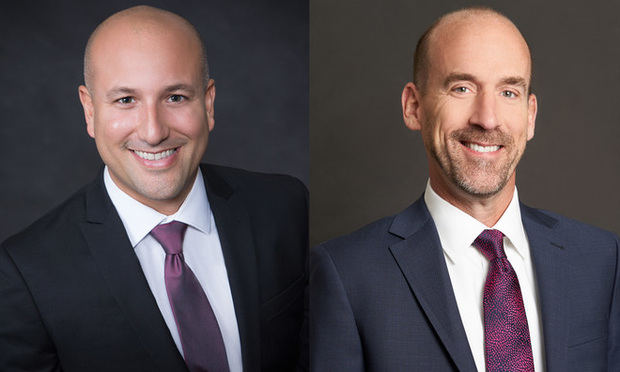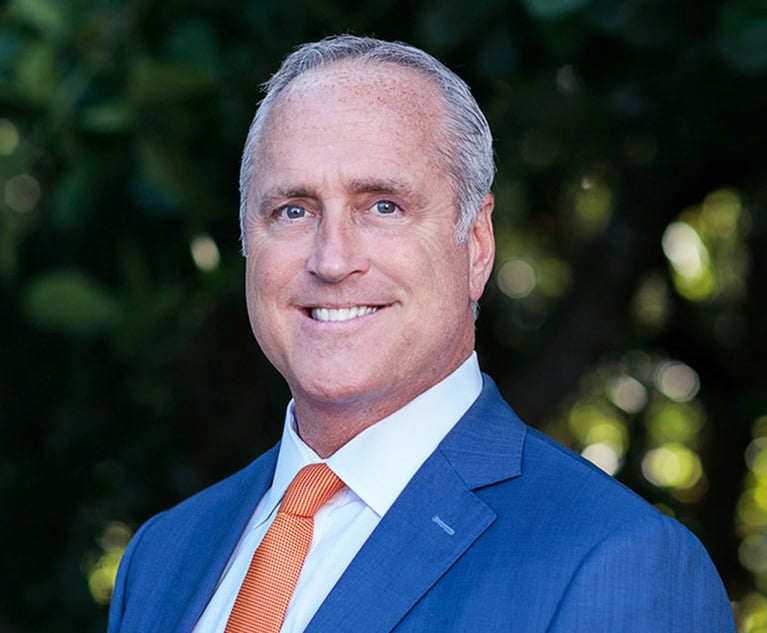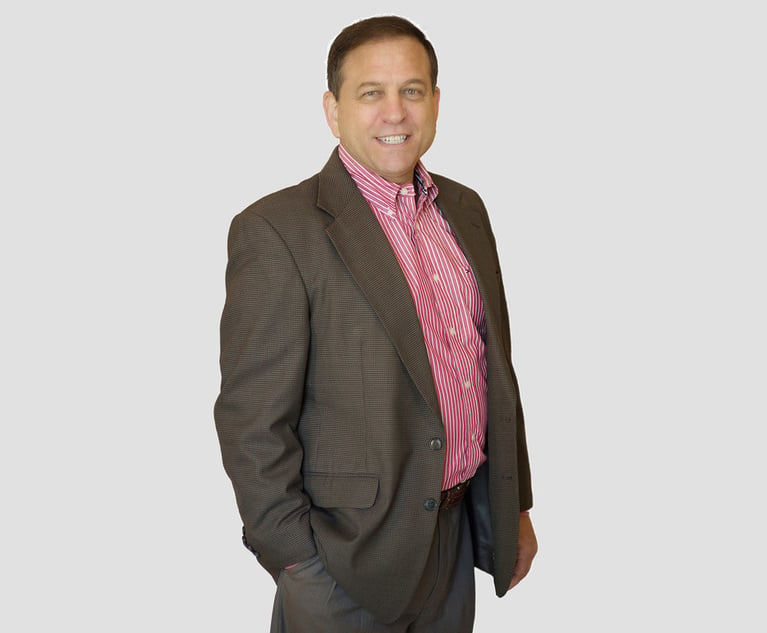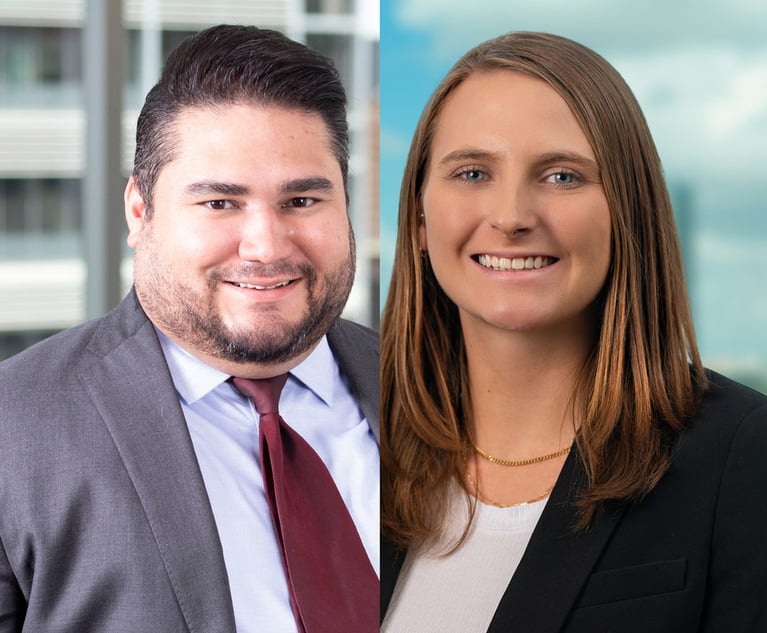Don't Be Clueless, Careless or Criminal: How to Legally Operate a Construction Zone Drone
The potential uses of unmanned aircraft systems (UAS) in the construction industry continue to expand as new technologies enter the market and construction companies realize UASes can perform unique tasks at tremendous cost savings.
May 14, 2018 at 10:19 AM
5 minute read

The potential uses of unmanned aircraft systems (UAS) in the construction industry continue to expand as new technologies enter the market and construction companies realize UASes can perform unique tasks at tremendous cost savings. The full technological capabilities of the UAS are, however, limited by law for public safety reasons. UASes share airspace with traditional passenger, military and cargo aircraft, and are potential hazards humans below. The risk of potential catastrophic collisions has led to a careful approach to the adoption of this technology.
Who Regulates Drone Usage?
All U.S. airspace is exclusively regulated by the Federal Aviation Administration (FAA), and therefore most drone regulation originates from this agency. Many states and localities have also enacted certain additional limits on UAS operations, but many of these nonfederal regulations are presently on unsure footing after a federal court ruling in Singer v. Newton invalidated a local regulation that conflicted with FAA regulations.
What is clear is that all commercial UAS operations must comply with FAA regulations, either under the older “Section 333 exemption” or the recently enacted “Part 107″ rules. Any drone operation conducted by a construction company, even through use of an employee's personal drone, would constitute commercial operation subject to regulation.
What Flight Rules Must an Operator Follow?
Because the Part 107 Rules are easier to administer for private drone operations, almost all drone usage in the construction industry is conducted under Part 107, not Section 333. Part 107 created a new form of FAA pilot certification exclusive to drone operators, and set forth clear operational rules that recognized that UAS were fundamentally different from other aircraft. Key elements of the rules are as follow:
Piloting: All UAS must be operated by someone in possession of an FAA pilot license, or new “Remote Pilot Airmen Certificate.” This certificate requires that the operator:
- Be age 16 years or older;
- Pass FAA administered aeronautical knowledge test;
- Pass TSA security vetting; and
- Renew certificate every two years.
Operation: The following restrictions are imposed on all flight operations:
- The UAS must weigh less than 55 pounds;
- Always in visual sight (VLOS);
- Fly in Class G airspace;
- Fly under 400 feet (or 400 feet above structure);
- Fly between sunrise and sunset;
- Airspeed of 100 mph or less;
- Must yield right of way to manned aircraft;
- Must not fly over nonparticipating humans;
- Must not fly from a moving vehicle (except in sparsely populated area); and
- Must not fly within five miles of an airport without prior approval.
Each of the above operation restrictions (but not piloting restrictions) may be waived by the FAA if a waiver is sought in advance by an operator who demonstrates a safe operation plan. Be aware, however, that waivers may take as long as 6 months to process. These waivers are not easy to obtain, and the vast majority are rejected by the FAA.
The FAA, in recognition of the long approval waiting period for waivers, recently announced that it is contemplating the creation of a “construction waiver,” geared toward the typical exceptions to the Part 107 rules that apply to the construction industry. What form such a construction waiver may take, the FAA presently takes the view that the drone operator must establish the procedures which will support its request for a waiver, recently telling operators to “build your safety case and present it.”
Can You Fly in South Florida?
Given the South Florida landscape, the biggest challenges for South Florida construction companies flying drones in their project sites will likely be the prohibition of flying over nonparticipating humans, and the restriction on flights within five miles of airports.
The nonparticipating humans restriction is broadly construed. In fact, only the drone crew is considered a “participating human”—all members of the public and workers on the construction site—are all nonparticipating humans, and drones may not fly over these persons without first obtaining a waiver. This is further complicated by how the FAA defines “flying over” a nonparticipant. While flying directly overhead is clearly flying “over” a nonparticipant, the width of the path is largely viewed as a variable on actual conditions, such as wind speed, height and speed of operation, size and type of drone, and other variable conditions. Accordingly, ensuring your drone is operated by a skilled pilot with current knowledge of FAA regulations, and flight risks, will minimize the risk that your drone is being flown illegally.
The requirement of notifying airports and air terminals when operating a drone within a five-mile radius also poses another logistical challenge. Fortunately, most commercial drone mapping systems will alert the pilot when an intended flight path will encroach on airport limits. Additionally, the FAA has launched a beta program, known as “LAANC,” which facilitates near real time automated processing of airspace notifications to airports of encroaching drone flight plans. This LAANC program is being rolled out nationally this year, with different regions of the United States coming online. LAANC is scheduled to roll out in South Florida on July 19, 2018.
Whether your construction enterprise has an ongoing UAS program, or is just getting started, operators must first become fully knowledgeable and compliant with the Part 107 Rules—to avoid becoming what the FAA describes as the “Three Cs”: the clueless, the careless, and the criminal.
Freddy X. Munoz is an associate in the Miami office of the national construction law firm of Peckar & Abramson. He may be reached at [email protected].
Mark R. Berry is a partner in the firm's Washington, D.C. office. He may be reached at [email protected].
This content has been archived. It is available through our partners, LexisNexis® and Bloomberg Law.
To view this content, please continue to their sites.
Not a Lexis Subscriber?
Subscribe Now
Not a Bloomberg Law Subscriber?
Subscribe Now
NOT FOR REPRINT
© 2025 ALM Global, LLC, All Rights Reserved. Request academic re-use from www.copyright.com. All other uses, submit a request to [email protected]. For more information visit Asset & Logo Licensing.
You Might Like
View All

Don’t Forget the Owner’s Manual: A Guide to Proving Liability Through Manufacturers’ Warnings and Instructions
5 minute read

Trending Stories
- 1No Two Wildfires Alike: Lawyers Take Different Legal Strategies in California
- 2Poop-Themed Dog Toy OK as Parody, but Still Tarnished Jack Daniel’s Brand, Court Says
- 3Meet the New President of NY's Association of Trial Court Jurists
- 4Lawyers' Phones Are Ringing: What Should Employers Do If ICE Raids Their Business?
- 5Freshfields Hires Ex-SEC Corporate Finance Director in Silicon Valley
Who Got The Work
J. Brugh Lower of Gibbons has entered an appearance for industrial equipment supplier Devco Corporation in a pending trademark infringement lawsuit. The suit, accusing the defendant of selling knock-off Graco products, was filed Dec. 18 in New Jersey District Court by Rivkin Radler on behalf of Graco Inc. and Graco Minnesota. The case, assigned to U.S. District Judge Zahid N. Quraishi, is 3:24-cv-11294, Graco Inc. et al v. Devco Corporation.
Who Got The Work
Rebecca Maller-Stein and Kent A. Yalowitz of Arnold & Porter Kaye Scholer have entered their appearances for Hanaco Venture Capital and its executives, Lior Prosor and David Frankel, in a pending securities lawsuit. The action, filed on Dec. 24 in New York Southern District Court by Zell, Aron & Co. on behalf of Goldeneye Advisors, accuses the defendants of negligently and fraudulently managing the plaintiff's $1 million investment. The case, assigned to U.S. District Judge Vernon S. Broderick, is 1:24-cv-09918, Goldeneye Advisors, LLC v. Hanaco Venture Capital, Ltd. et al.
Who Got The Work
Attorneys from A&O Shearman has stepped in as defense counsel for Toronto-Dominion Bank and other defendants in a pending securities class action. The suit, filed Dec. 11 in New York Southern District Court by Bleichmar Fonti & Auld, accuses the defendants of concealing the bank's 'pervasive' deficiencies in regards to its compliance with the Bank Secrecy Act and the quality of its anti-money laundering controls. The case, assigned to U.S. District Judge Arun Subramanian, is 1:24-cv-09445, Gonzalez v. The Toronto-Dominion Bank et al.
Who Got The Work
Crown Castle International, a Pennsylvania company providing shared communications infrastructure, has turned to Luke D. Wolf of Gordon Rees Scully Mansukhani to fend off a pending breach-of-contract lawsuit. The court action, filed Nov. 25 in Michigan Eastern District Court by Hooper Hathaway PC on behalf of The Town Residences LLC, accuses Crown Castle of failing to transfer approximately $30,000 in utility payments from T-Mobile in breach of a roof-top lease and assignment agreement. The case, assigned to U.S. District Judge Susan K. Declercq, is 2:24-cv-13131, The Town Residences LLC v. T-Mobile US, Inc. et al.
Who Got The Work
Wilfred P. Coronato and Daniel M. Schwartz of McCarter & English have stepped in as defense counsel to Electrolux Home Products Inc. in a pending product liability lawsuit. The court action, filed Nov. 26 in New York Eastern District Court by Poulos Lopiccolo PC and Nagel Rice LLP on behalf of David Stern, alleges that the defendant's refrigerators’ drawers and shelving repeatedly break and fall apart within months after purchase. The case, assigned to U.S. District Judge Joan M. Azrack, is 2:24-cv-08204, Stern v. Electrolux Home Products, Inc.
Featured Firms
Law Offices of Gary Martin Hays & Associates, P.C.
(470) 294-1674
Law Offices of Mark E. Salomone
(857) 444-6468
Smith & Hassler
(713) 739-1250






